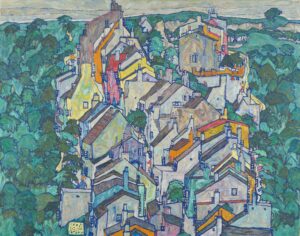On Thursday, October 17th, New York’s Neue Galerie unveiled its new exhibition, Egon Schiele: Living Landscapes. The Neue Galerie is a small museum in a converted Fifth Avenue mansion specializing in twentieth-century German and Austrian art. It is also known for its Central European-style café. When I visited on Sunday, it seemed like half of the people in the line outside the front door were exclusively there to have lunch. But the Neue Galerie is one of the best places to see the work of artists like Gustav Klimt, Ernst Ludwig Kirchner, and Egon Schiele. While predominantly known for his distinctive figure paintings, Schiele was primarily fascinated with life in general, making his landscapes a vital supplement to his more well-known work.
The exhibition occupies four rooms and a corridor on the top floor of the museum’s building. It starts with Schiele’s childhood in the Austrian countryside. While he is often associated with the transition between the fin de siècle Viennese painters and the urban interwar Expressionists, he spent much of his life in towns like Klosterneuburg, in the rural areas to the northwest of the city. The curators highlight a pastoral yet somewhat turbulent childhood. Schiele would focus on decay and death in much of his work, expressed through his autumnal and winter landscapes. This was, in no small part, due to his father’s mental and physical deterioration from untreated syphilis, which included a suicide attempt when Schiele was 14 years old. He attended the Vienna Academy of Fine Arts starting in 1906, and much of his work between 1906 and 1909 consisted of oil paintings on board reminiscent of earlier paintings by Post-Impressionist masters. Still, he would not exhibit in Vienna until Gustav Klimt invited him to show four paintings at the Internationale Kunstschau. Despite his association with portraiture and other figure paintings, landscapes and other paintings of Austrian small-town life comprise the greatest bulk of Schiele’s total work. Apart from the occasional trip to the theater or a coffeehouse, he actively disliked Vienna and city life. He once wrote, “In Vienna there is only shadow, the city is black, everything is done by recipe.” He much preferred life in towns such as Krumau, Wachau, or Stein. His ‘townscapes,’ which started in 1911, are much different from his early landscapes. He broke away from the trappings of Post-Impressionism and brought the color palette and techniques of Symbolism and Expressionism, as seen in paintings like Town among Greenery.
However, the show is not completely devoid of Schiele’s more recognizable figure paintings. One of the galleries emphasized how Schiele became an innovator in portraiture by playing with concepts of subject and background by sometimes completely eliminating the background. This is most notable when the subject interacts with other elements in the scene, like in his Portrait of Karl Zakovšek, where the subject appears to be reclining in an armchair. However, the chair is absent, as is everything else in the background, so the subject is simply floating as if in a void. But there were also times when Schiele blended the subject and background into one, and the differentiation between figure and landscape painting blurred. This is best shown by his Current of Youth (Danaë) melding human and natural motifs. In an adjacent room, the curators show fragments of Schiele’s letters and his interests outside his art. His writings show that he made no differentiation between the different genres and that figure painting and landscape are just parts of the unity of all life.
Egon Schiele’s portraits, nudes, and figure paintings are his most distinctive works, yet his landscapes and townscapes are far more important when studying his work as an artist and an individual. Though small, the Neue Galerie exhibition was very comprehensive in looking at Schiele’s multifacetedness and his ability to transcend genre. It was very much worth the visit. Egon Schiele: Living Landscapes will be on view until January 13, 2025.

